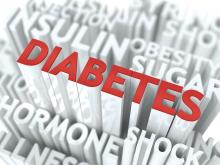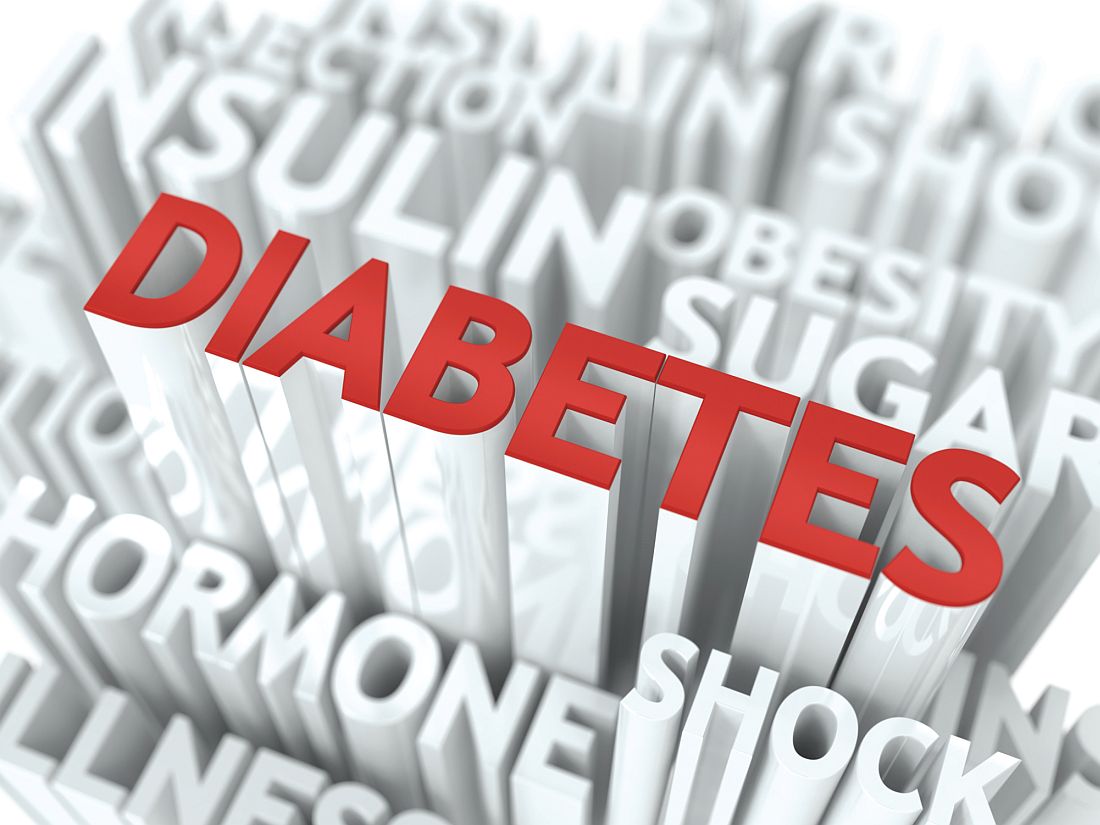User login
WASHINGTON – More than half of men with type 1 or type 2 diabetes develop erectile dysfunction, making them more than three times as likely to develop ED, compared with healthy men, according to a systematic review of diabetes studies.
Data on the exact prevalence of erectile dysfunction in this population has been lacking until now. More precise figures are available from a meta-analysis of 145 studies taken from international diabetes databases.
In terms of risk, men with diabetes were 3.62 (95% CI, 2.53-5.16; P less than .0001) times more likely to develop ED, compared with healthy controls, according to investigators (Diabet Med. 2017 Jul 18. doi: 10.1111/dme.13403).
“Regarding sexual activity and the psychological impact of erectile dysfunction in men with diabetes mellitus, significant and positive associations have been found between depressive symptoms and erectile dysfunction,” said Youssef Kouidrat, MD, PhD, of the department of psychosis studies, Institute of Psychiatry, King’s College London, and his fellow researchers. “Therefore, early detection of erectile dysfunction is essential to improve the psychological health and men’s quality of life.”
Given ED’s serious effects on patients’ physical and emotional well being, it is essential for physicians to have a better understanding of the root causes of the condition in order to help patients as soon as possible, wrote the investigators.
The studies included in the meta-analysis represented a population of 88.755 men with an average age of 56 years, with dates of the studies ranging from the inception of the databases they were taken from up until November 2016.
A majority of the studies included were conducted in Asia (61), followed by Europe (48), North America (17), Africa (15), and Oceania, South America, and multiple continents (4 in total).
South America reported the highest prevalence of ED (74.6%), while the lowest prevalence reported was among studies in North America (34.5%).
Patients who were assessed using the Sexual Health Inventory for Men (SHIM) score reported a higher ED prevalence (82.2%), as did men above the age of 60 years old (62.2%).
With ED correlated to cardiovascular health and mortality, investigators advise physicians to keep testing in mind when assessing patients’ cardiovascular risk.
This study was limited by incomplete data from studies included, which made it difficult to determine prevalence by certain categories.
Other limitations included the lack of separation between type 1 and type 2 diabetes among many of the studies analyzed, as well as a lack of information from the studies analyzed on other risk factors concerning diabetes-related erectile dysfunction.
Investigators reported no relevant financial disclosures.
[email protected]
On Twitter @eaztweets
WASHINGTON – More than half of men with type 1 or type 2 diabetes develop erectile dysfunction, making them more than three times as likely to develop ED, compared with healthy men, according to a systematic review of diabetes studies.
Data on the exact prevalence of erectile dysfunction in this population has been lacking until now. More precise figures are available from a meta-analysis of 145 studies taken from international diabetes databases.
In terms of risk, men with diabetes were 3.62 (95% CI, 2.53-5.16; P less than .0001) times more likely to develop ED, compared with healthy controls, according to investigators (Diabet Med. 2017 Jul 18. doi: 10.1111/dme.13403).
“Regarding sexual activity and the psychological impact of erectile dysfunction in men with diabetes mellitus, significant and positive associations have been found between depressive symptoms and erectile dysfunction,” said Youssef Kouidrat, MD, PhD, of the department of psychosis studies, Institute of Psychiatry, King’s College London, and his fellow researchers. “Therefore, early detection of erectile dysfunction is essential to improve the psychological health and men’s quality of life.”
Given ED’s serious effects on patients’ physical and emotional well being, it is essential for physicians to have a better understanding of the root causes of the condition in order to help patients as soon as possible, wrote the investigators.
The studies included in the meta-analysis represented a population of 88.755 men with an average age of 56 years, with dates of the studies ranging from the inception of the databases they were taken from up until November 2016.
A majority of the studies included were conducted in Asia (61), followed by Europe (48), North America (17), Africa (15), and Oceania, South America, and multiple continents (4 in total).
South America reported the highest prevalence of ED (74.6%), while the lowest prevalence reported was among studies in North America (34.5%).
Patients who were assessed using the Sexual Health Inventory for Men (SHIM) score reported a higher ED prevalence (82.2%), as did men above the age of 60 years old (62.2%).
With ED correlated to cardiovascular health and mortality, investigators advise physicians to keep testing in mind when assessing patients’ cardiovascular risk.
This study was limited by incomplete data from studies included, which made it difficult to determine prevalence by certain categories.
Other limitations included the lack of separation between type 1 and type 2 diabetes among many of the studies analyzed, as well as a lack of information from the studies analyzed on other risk factors concerning diabetes-related erectile dysfunction.
Investigators reported no relevant financial disclosures.
[email protected]
On Twitter @eaztweets
WASHINGTON – More than half of men with type 1 or type 2 diabetes develop erectile dysfunction, making them more than three times as likely to develop ED, compared with healthy men, according to a systematic review of diabetes studies.
Data on the exact prevalence of erectile dysfunction in this population has been lacking until now. More precise figures are available from a meta-analysis of 145 studies taken from international diabetes databases.
In terms of risk, men with diabetes were 3.62 (95% CI, 2.53-5.16; P less than .0001) times more likely to develop ED, compared with healthy controls, according to investigators (Diabet Med. 2017 Jul 18. doi: 10.1111/dme.13403).
“Regarding sexual activity and the psychological impact of erectile dysfunction in men with diabetes mellitus, significant and positive associations have been found between depressive symptoms and erectile dysfunction,” said Youssef Kouidrat, MD, PhD, of the department of psychosis studies, Institute of Psychiatry, King’s College London, and his fellow researchers. “Therefore, early detection of erectile dysfunction is essential to improve the psychological health and men’s quality of life.”
Given ED’s serious effects on patients’ physical and emotional well being, it is essential for physicians to have a better understanding of the root causes of the condition in order to help patients as soon as possible, wrote the investigators.
The studies included in the meta-analysis represented a population of 88.755 men with an average age of 56 years, with dates of the studies ranging from the inception of the databases they were taken from up until November 2016.
A majority of the studies included were conducted in Asia (61), followed by Europe (48), North America (17), Africa (15), and Oceania, South America, and multiple continents (4 in total).
South America reported the highest prevalence of ED (74.6%), while the lowest prevalence reported was among studies in North America (34.5%).
Patients who were assessed using the Sexual Health Inventory for Men (SHIM) score reported a higher ED prevalence (82.2%), as did men above the age of 60 years old (62.2%).
With ED correlated to cardiovascular health and mortality, investigators advise physicians to keep testing in mind when assessing patients’ cardiovascular risk.
This study was limited by incomplete data from studies included, which made it difficult to determine prevalence by certain categories.
Other limitations included the lack of separation between type 1 and type 2 diabetes among many of the studies analyzed, as well as a lack of information from the studies analyzed on other risk factors concerning diabetes-related erectile dysfunction.
Investigators reported no relevant financial disclosures.
[email protected]
On Twitter @eaztweets
FROM DIABETIC MEDICINE
Key clinical point:
Major finding: Men with diabetes showed an odds ratio of 3.62 (95% CI, 2.53-5.16; P less than .0001) of developing erectile dysfunction, compared with healthy controls.
Data source: An analysis of 145 studies representing 88,577 men from international databases spanning from creation of the database to November 2016.
Disclosures: Investigators report no relevant financial disclosures.

